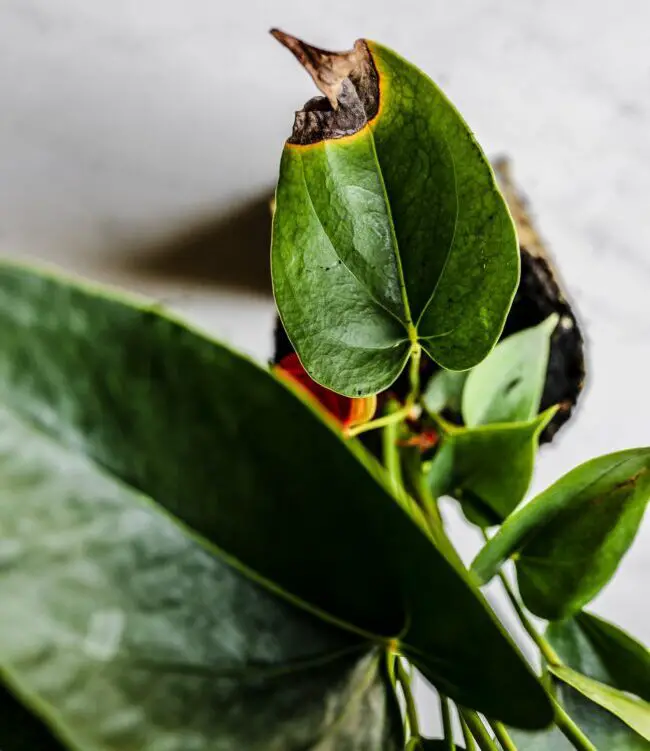Are your anthurium leaves turning brown? Don’t worry, we’ve got the solution for you! Brown leaves on anthurium plants can be a sign of various issues, including improper care or environmental factors.
But fret not, because in this article, we’ll delve into the root causes of this problem and provide easy-to-follow tips to help your anthurium flourish. So, if you’ve been wondering why your anthurium leaves are turning brown, keep reading to unlock the secrets to lush, vibrant foliage.
Anthurium Leaves Turning Brown: Causes, Prevention, and Treatment
Anthuriums, also known as Flamingo Flowers or Painter’s Palette, are popular houseplants appreciated for their stunning, glossy foliage and beautiful flowers. However, seeing their leaves turning brown can be a cause for concern among plant enthusiasts.
In this article, we will explore the various reasons why anthurium leaves may turn brown and discuss preventive measures and treatment options to keep your plant healthy and vibrant.
Understanding Anthuriums and Leaf Health
Before we delve into the factors causing brown leaves on anthuriums, let’s first understand the plant and the importance of leaf health. Anthuriums are native to the tropical rainforests of Central and South America, where they thrive in warm, humid conditions. They have broad, heart-shaped leaves that are typically glossy and vibrant green when healthy.
Leaves are vital for plants as they play a crucial role in photosynthesis, the process by which plants convert sunlight into energy. Healthy leaves also aid in transpiration, the release of excess moisture from the plant. When the leaves of anthuriums begin to turn brown, it is often an indication that something is amiss, and the plant requires attention.
Common Causes of Anthurium Leaves Turning Brown
There are several factors that can contribute to anthurium leaves turning brown. Identifying the underlying cause is essential for providing the appropriate treatment. Let’s explore some common reasons:
1. Exposure to Direct Sunlight
Anthuriums are naturally shaded by taller trees in their native habitats, making them more adapted to low to medium light conditions.
Exposing them to direct sunlight can cause their leaves to brown and scorch. To prevent this, it’s important to place your anthurium in a location with bright, indirect light, away from windows that receive intense sunlight.
2. Overwatering or Underwatering
Both overwatering and underwatering can lead to browning leaves in anthuriums. Overwatering can suffocate the roots, leading to root rot and nutrient deficiencies, while underwatering deprives the plant of necessary moisture.
- Ensure proper watering by checking the soil moisture level. Stick your finger about an inch into the soil – if it feels dry, it’s time to water, but if it feels moist, hold off for a few more days.
- Use well-draining soil that allows excess water to flow out easily, preventing waterlogging.
- Consider using a moisture meter to accurately assess the watering needs of your anthurium.
3. Improper Humidity Levels
As tropical plants, anthuriums thrive in high humidity environments. Insufficient humidity can cause their leaves to dry out and turn brown. Here are some tips to create a suitable humidity level for your anthurium:
- Mist the leaves regularly with room temperature water to increase humidity around the plant.
- Place a tray filled with water and pebbles beneath the plant’s pot. As the water evaporates, it creates a humid microclimate.
- Consider using a humidifier to maintain optimal humidity levels, especially during dry seasons or in air-conditioned rooms.
4. Inadequate Ventilation
Poor air circulation can contribute to the browning of anthurium leaves. Stagnant air can lead to the build-up of excess moisture, making the plant more susceptible to fungal diseases. Ensure proper ventilation by:
- Placing the anthurium in an area with good air movement, away from drafts or extreme temperature fluctuations.
- Using a fan to gently circulate air around the plant without subjecting it to direct wind.
5. Pest Infestation
Pests, such as aphids, spider mites, or thrips, can cause damage to anthurium leaves, resulting in browning.
It’s essential to regularly inspect your plant for any signs of pest infestation, such as visible pests, webbing, or distorted leaves. If pests are detected:
- Isolate the affected plant to prevent the infestation from spreading.
- Remove any visible pests manually with a soft cloth or cotton swab dipped in soapy water.
- Treat the plant with an appropriate insecticidal soap or horticultural oil, following the product instructions carefully.
Treating Anthurium Leaves Turning Brown
Once the cause of the brown leaves has been identified, appropriate treatment can be implemented to restore the plant’s health. Here are some steps to consider based on the cause:
1. Addressing Sunlight Issues
If your anthurium is exposed to direct sunlight, consider moving it to a location with bright, indirect light. Ensure the plant is at a safe distance from windows or use sheer curtains to filter the sunlight.
This will help prevent further leaf browning and promote healthy growth.
2. Correcting Watering Practices
To address overwatering or underwatering issues:
- Adjust your watering schedule according to the moisture needs of your anthurium.
- Ensure proper drainage by repotting your plant using well-draining soil.
- Trim or remove any rotted roots to prevent further damage to the plant.
3. Enhancing Humidity
To increase humidity levels around your anthurium:
- Mist the leaves regularly, especially during dry periods.
- Place a tray with water and pebbles under the pot to create a humid microenvironment.
- Consider grouping plants together to create a humid microclimate.
- Use a humidifier in the vicinity of the plant.
4. Improving Air Circulation
To enhance air circulation around your anthurium:
- Ensure the plant is placed in an area with good air movement.
- Use a gentle fan to promote air circulation without subjecting the plant to direct wind.
5. Combating Pest Infestation
To eliminate pests and prevent further damage:
- Isolate the affected plant to prevent the infestation from spreading.
- Manually remove visible pests using a soft cloth or cotton swab dipped in soapy water.
- Treat the plant with an appropriate insecticidal soap or horticultural oil, following the product instructions carefully.
Anthuriums are magnificent plants that can bring beauty and elegance to any indoor space. Understanding why their leaves turn brown and implementing proper care techniques is crucial for keeping them healthy.
By addressing sunlight exposure, watering practices, humidity levels, air circulation, and pest infestations, you can prevent and treat brown leaves on anthuriums. Remember, observation, care, and timely intervention are key to maintaining the lush foliage and vibrant blooms of these remarkable plants.
Frequently Asked Questions (FAQs)
Anthurium leaves can turn brown due to various reasons. It could be caused by overwatering, underwatering, excessive sunlight, low humidity, or pest infestation.
To prevent anthurium leaves from turning brown, it is important to maintain a proper watering schedule. Water the plant thoroughly once the top inch of the soil feels dry to the touch, but avoid overwatering as it can lead to root rot and brown leaves.
Anthuriums thrive in high humidity levels. To increase humidity, you can mist the leaves regularly, place the plant on a tray with water and pebbles, or use a humidifier in the room. This will help prevent the leaves from turning brown.
Yes, direct sunlight can cause anthurium leaves to turn brown. The plant prefers bright, indirect light. Exposing it to direct sunlight for extended periods can lead to sunburn and brown leaves. It is recommended to place the plant in a location with filtered or indirect light.
To prevent pest infestation on anthuriums, regularly inspect the plant for common pests like aphids, mealybugs, or spider mites. If you notice any signs of infestation, treat the plant with insecticidal soap or a neem oil solution. Quarantine any affected plants to prevent the spread of pests.
Brown tips on anthurium leaves are usually caused by underwatering or low humidity. Ensure that the plant is receiving adequate water and increase humidity levels around the plant. Trimming off the brown tips with clean, sharp scissors can also help improve the overall appearance of the plant.
Fertilizing anthuriums can promote healthy growth and prevent nutrient deficiencies that may lead to brown leaves. Use a balanced, water-soluble fertilizer specifically formulated for houseplants. Follow the instructions on the package and avoid over-fertilizing, as this can damage the plant.
Anthuriums thrive in temperatures between 60-80°F (15-27°C). Avoid exposing the plant to extreme temperature fluctuations, drafts, or cold air, as these can cause stress and result in brown leaves. Maintain a consistent room temperature to promote healthy foliage.
Final Thoughts
Anthurium leaves turning brown is a common issue that can be caused by various factors. One of the main reasons for this problem is overwatering, as excess moisture can lead to root rot and browning of the leaves. Inadequate lighting can also cause the leaves to turn brown, as anthuriums thrive in bright indirect light. Additionally, low humidity levels can result in dryness and browning of the leaves.
To prevent this issue, it is essential to provide proper watering, adequate lighting, and increased humidity through misting or using a humidifier. Regularly monitoring the plant’s health and making necessary adjustments will help maintain the vibrant and healthy appearance of the leaves.
Auto Amazon Links: No products found.
Perfect Plants Christmas Tree Saver 8oz. | Easy Use Xmas Tree Preserver Food | Have Healthy Green Christmas Trees All Holiday Season
$9.97 (as of December 11, 2025 04:08 GMT +00:00 - More info- Product prices and availability are accurate as of the date/time indicated and are subject to change. Any price and availability information displayed on [relevant Amazon Site(s), as applicable] at the time of purchase will apply to the purchase of this product.
Rocky Mountain Goods Christmas Tree Food - 8 oz Tree Preservative - Reduce Needle Drop - Greener Scent - Fir, Pine, Spruce Trees - Extend Tree Life
$9.95 (as of December 11, 2025 04:08 GMT +00:00 - More info- Product prices and availability are accurate as of the date/time indicated and are subject to change. Any price and availability information displayed on [relevant Amazon Site(s), as applicable] at the time of purchase will apply to the purchase of this product.
VICAMB 39.3 Inch Christmas Tree Watering Funnel,Christmas Tree Watering System Device,Long Tree Watering Funnel Spout for Indoor Outdoor Xmas Tree
$16.99 (as of December 11, 2025 04:08 GMT +00:00 - More info- Product prices and availability are accurate as of the date/time indicated and are subject to change. Any price and availability information displayed on [relevant Amazon Site(s), as applicable] at the time of purchase will apply to the purchase of this product.
SUNEZLGO Christmas Tree Watering Funnel, Christmas Tree Watering System Tree Waterer, Real Christmas Tree Water Funnel, Xmas Adjustable Metal Tubes Spout for Indoor Outdoor Christmas Tree
$19.99 (as of December 11, 2025 04:08 GMT +00:00 - More info- Product prices and availability are accurate as of the date/time indicated and are subject to change. Any price and availability information displayed on [relevant Amazon Site(s), as applicable] at the time of purchase will apply to the purchase of this product.
EZMeetU Christmas Tree Watering Funnel, 47 Inch Flower Shape Adjustable 6 Section Design, Christmas Tree Watering System, Christmas Tree Waterer, Long Funnel Wide Opening Reusable, Plant Watering Tool
$16.99 (as of December 11, 2025 04:08 GMT +00:00 - More info- Product prices and availability are accurate as of the date/time indicated and are subject to change. Any price and availability information displayed on [relevant Amazon Site(s), as applicable] at the time of purchase will apply to the purchase of this product.
Muddy Mat® Shown on TV Super Absorbent Microfiber Dog Door Mat for Muddy Paws, Non-Slip Washable Pet Rug, Quick Dry Chenille Entryway Carpet, Machine Washable Indoor Outdoor mat, Grey 30"x19"
$24.95 (as of December 9, 2025 17:49 GMT +00:00 - More info- Product prices and availability are accurate as of the date/time indicated and are subject to change. Any price and availability information displayed on [relevant Amazon Site(s), as applicable] at the time of purchase will apply to the purchase of this product.
Snow Joe Premium Enviro Blend Ice Melt, Green-Coated Deicer Crystals, 50 lb - Safer Melter for Vegetation, Concrete & Metals w/ Anti-Corrosion Calcium Magnesium Acetate
$32.97 (as of December 9, 2025 17:49 GMT +00:00 - More info- Product prices and availability are accurate as of the date/time indicated and are subject to change. Any price and availability information displayed on [relevant Amazon Site(s), as applicable] at the time of purchase will apply to the purchase of this product.
Zevo Flying Insect Trap Official Refill Cartridges - Fits Both Zevo Trap & MAX Indoor Fly Trap - Authentic Trap+Lock Technology to Catch Gnats, House & Fruit Flys (4 Official Refill Cartridges)
$11.01 (as of December 9, 2025 17:49 GMT +00:00 - More info- Product prices and availability are accurate as of the date/time indicated and are subject to change. Any price and availability information displayed on [relevant Amazon Site(s), as applicable] at the time of purchase will apply to the purchase of this product.
OLANLY Dog Door Mat for Muddy Paws 30x20, Absorbs Moisture and Dirt, Absorbent Non-Slip Washable Doormat, Quick Dry Chenille Mud Mat for Dogs, Entry Indoor Entryway Carpet for Inside Floor, Grey
$9.99 (as of December 9, 2025 17:49 GMT +00:00 - More info- Product prices and availability are accurate as of the date/time indicated and are subject to change. Any price and availability information displayed on [relevant Amazon Site(s), as applicable] at the time of purchase will apply to the purchase of this product.
ivtivfu Rolling Grill Basket, Removable Wooden Handle, 304 Stainless Steel, Nesting BBQ Tools, Smoker Grilling Accessories for Vegetable, Outdoor Cooking Camping, Birthday Gifts for Men Dad Husband
$24.99 (as of December 9, 2025 17:49 GMT +00:00 - More info- Product prices and availability are accurate as of the date/time indicated and are subject to change. Any price and availability information displayed on [relevant Amazon Site(s), as applicable] at the time of purchase will apply to the purchase of this product.











